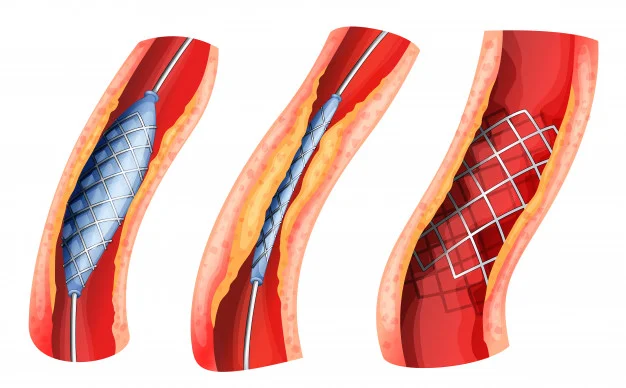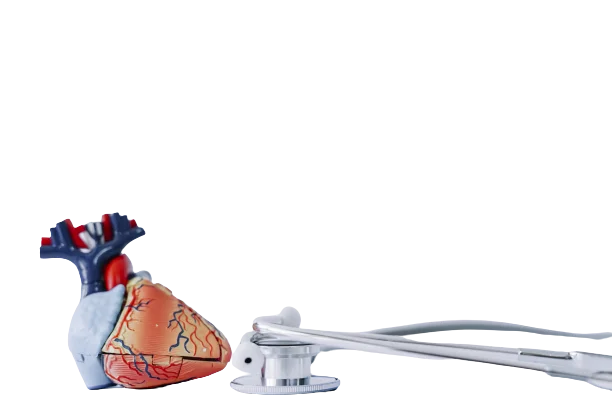Book Your Appointment
Angioplasty and stents Treatment
Get At Swasthyam Superspeciality Hospital
Angioplasty And Stents Treatment
Coronary angioplasty (AN-jee-o-plas-tee), also called percutaneous coronary intervention, is a procedure used to open clogged heart arteries. Angioplasty uses a tiny balloon catheter that is inserted in a blocked blood vessel to help widen it and improve blood flow to your heart.
Angioplasty is often combined with the placement of a small wire mesh tube called a stent. The stent helps prop the artery open, decreasing its chance of narrowing again. Most stents are coated with medication to help keep your artery open (drug-eluting stents). Rarely, bare-metal stents may be used.
Angioplasty can improve symptoms of blocked arteries, such as chest pain and shortness of breath. Angioplasty is also often used during a heart attack to quickly open a blocked artery and reduce the amount of damage to your heart.

Why it’s done?
Angioplasty is used to treat the buildup of fatty plaques in your heart’s blood vessels. This buildup is a type of heart disease known as atherosclerosis.
Angioplasty may be a treatment option for you if:
- ou have tried medications or lifestyle changes but these have not improved your heart health.
- You have chest pain (angina) that is worsening.
- You have a heart attack. Angioplasty can quickly open a blocked artery, reducing damage to your heart.
Angioplasty isn’t for everyone. Depending on the extent of your heart disease and your overall health, your doctor may determine that coronary artery bypass surgery is a better option than angioplasty for you.
You may need coronary artery bypass surgery if:
- The main artery that brings blood to the left side of your heart is narrow
- Your heart muscle is weak
- You have diabetes and multiple severe blockages in your arteries
In coronary artery bypass surgery, the blocked part of your artery is bypassed using a healthy blood vessel from another part of your body.
Risks
Although angioplasty is a less invasive way to open clogged arteries than bypass surgery is, the procedure still carries some risks.
The most common angioplasty risks include:
- Re-narrowing of your artery. When angioplasty is combined with drug-eluting stent placement, there’s a small risk the treated artery may become clogged again (less than 5%). The risk of re-narrowing of the artery is about 10% to 20% when bare-metal stents are used.
- Blood clots. Blood clots can form within stents even after the procedure. These clots can close the artery, causing a heart attack. It’s important to take aspirin in combination with clopidogrel (Plavix), prasugrel (Effient) or another medication that helps reduce the risk of blood clots exactly as prescribed to decrease the chance of clots forming in your stent.
Talk to your doctor about how long you’ll need to take these medications. Never discontinue these medications without discussing it with your doctor.
- Bleeding. You may have bleeding in your leg or arm where a catheter was inserted. Usually this simply results in a bruise, but sometimes serious bleeding occurs and may require a blood transfusion or surgical procedures.

Risks

Although angioplasty is a less invasive way to open clogged arteries than bypass surgery is, the procedure still carries some risks.
The most common angioplasty risks include:
- Re-narrowing of your artery. When angioplasty is combined with drug-eluting stent placement, there’s a small risk the treated artery may become clogged again (less than 5%). The risk of re-narrowing of the artery is about 10% to 20% when bare-metal stents are used.
- Blood clots. Blood clots can form within stents even after the procedure. These clots can close the artery, causing a heart attack. It’s important to take aspirin in combination with clopidogrel (Plavix), prasugrel (Effient) or another medication that helps reduce the risk of blood clots exactly as prescribed to decrease the chance of clots forming in your stent.
Talk to your doctor about how long you’ll need to take these medications. Never discontinue these medications without discussing it with your doctor.
- Bleeding. You may have bleeding in your leg or arm where a catheter was inserted. Usually this simply results in a bruise, but sometimes serious bleeding occurs and may require a blood transfusion or surgical procedures.
Results
Coronary angioplasty greatly increases blood flow through the previously narrowed or blocked coronary artery. Your chest pain generally should decrease, and you may be better able to exercise.
Having angioplasty and stenting doesn’t mean your heart disease goes away. You’ll need to continue healthy lifestyle habits and take medications as prescribed by your doctor.
If you experience symptoms similar to those you had before your procedure, such as chest pain or shortness of breath, contact your doctor. If you have chest pain at rest or pain that doesn’t respond to nitroglycerin, call 911 or emergency medical help.
-
To keep your heart healthy after angioplasty, you should:
- Quit smoking
- Lower your cholesterol levels
- Eat a healthy diet that is low in saturated fat
- Maintain a healthy weight
- Control other conditions, such as diabetes and high blood pressure
- Get regular exercise
- Take medications as prescribed by your doctor
Successful angioplasty also means you might not have to undergo coronary artery bypass surgery, a more invasive procedure that requires longer recovery time.
Prevention
The same healthy lifestyle changes recommended to treat atherosclerosis also help prevent it. These include:
- Quitting smoking
- Eating healthy foods
- Exercising regularly
- Maintaining a healthy weight
-
Just remember to make changes one step at a time, and keep in mind what lifestyle changes are manageable for you in the long run.

Message Us
Get In touch with us. Ask Any Question or Book Your Appointment Now
Emergency
+91-8600888444
Book An Appointment
0712-2222111
Contact Us
Location
97/98 Vivekanand Nagar, Near Sai Mandir, Wardha Road, Nagpur
Contact for
Emergency :- +91-8600888444
Book An Appointment:- 0712-2222111
